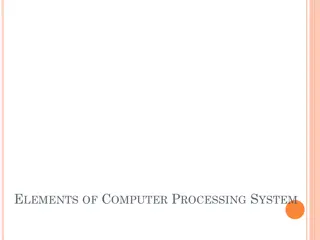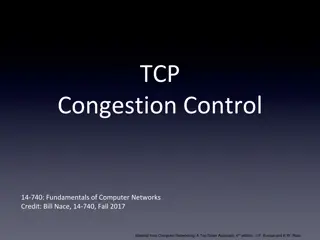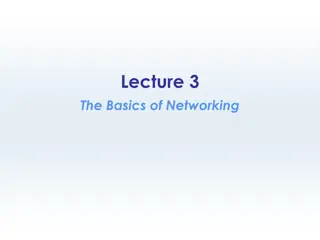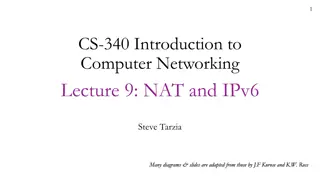
Computer Networking Basics and Types
Explore the fundamentals of computer networking, including network components, types of networks, communication channels, and network devices. Learn about LAN, MAN, and WAN networks, hardware, software, network topologies, and communication media used for data exchange.
Uploaded on | 3 Views
Download Presentation

Please find below an Image/Link to download the presentation.
The content on the website is provided AS IS for your information and personal use only. It may not be sold, licensed, or shared on other websites without obtaining consent from the author. If you encounter any issues during the download, it is possible that the publisher has removed the file from their server.
You are allowed to download the files provided on this website for personal or commercial use, subject to the condition that they are used lawfully. All files are the property of their respective owners.
The content on the website is provided AS IS for your information and personal use only. It may not be sold, licensed, or shared on other websites without obtaining consent from the author.
E N D
Presentation Transcript
BASICS OF BASICS OF COMPUTER NET WORKING NET WORKING COMPUTER UNIT I
TOPICS Networking basics Need for computer networks Types of networks-LAN, MAN, WAN Network Components H/W, Software Communication channels Network Devices Network topologies.
NETWORKING INTRODUCTION A network is a collection of independent computers which are connected together to share information and resources. In addition to computers, a network also consists of peripheral devices and data communication devices with transmission media used for the purpose of exchanging data and information. Need for computer networking To share computer Data/Programs To share computer Resources Bandwidth Bandwidth refers to the maximum volume of information that can be transferred over any communication medium.
TYPES OF NETWORKS TYPES OF NETWORKS Based on the geographical area covered by the network, networks can be classified as follows: LocalArea Network (LAN): A data communication network that connects computers together in a room, building or a campus is called a Local area network . A Metropolitan Area Network (MAN): A MAN typically covers an area of between 5 to 50 kms. A wide area network (WAN): It is a system of interconnecting many computers over a large geographical area such as cities, states, countries or even the whole world.
NETWORK COMPONENTS Hardware Software Communication Channels Network Devices
COMMUNICATION CHANNELS Communication Channels refers to the physical media through which communication signals are transmitted. The two commonly used types of cables (Wired TM) to connect computers are coaxial cables and fiber optic cables.
WIRELESS TM WIRELESS TM- - MICROWAVE MICROWAVE SYSTEMS SYSTEMS COMMUNICATION SATELLITE COMMUNICATION SATELLITE
NETWORK DEVICES Different networking devices have different roles to play in a computer network. These network devices also work at different segments of a computer network performing different functions. Examples of Network devices are: Hub Switch Router Bridge Gateway Modem, etc.
NETWORK TOPOLOGIES A network topology is the arrangement of a network, including its nodes and connecting lines. It defines the way different nodes are placed and interconnected with each other. Types of Network Topologies: Bus Topology Star Topology Ring Topology Mesh Topology






















